traderkenny
Active member
- Messages
- 106
- Likes
- 4
Peak Gold?
One of the first fundamentals a trader learns is the importance of the supply and demand for a commodity or resource. Gold and other precious metals markets are no exception. Analyzing grains and other consumables requires all the details on consumption, production, and storage. For metals, the attention falls on investment demand and mining production. Unlike corn or wheat, new production or mining is limited to what is in the earth, an idea not overlooked by peak gold theorists.
Peak gold arguments, similar to those that drive peak oil theories, suggest that there is a pinnacle of production which can be reached and that following that peak, the mining or production levels will end up in terminal decline. More than one industry name has suggested that this peak was already reached at the beginning of the new millennium. Other publications, like those from the US Geological Survey (USGS), suggest that gold resources still exist to be discovered. Scrap and alloy uses may deflect some of the impact, but first it is important to evaluate where gold is and where it is coming from.
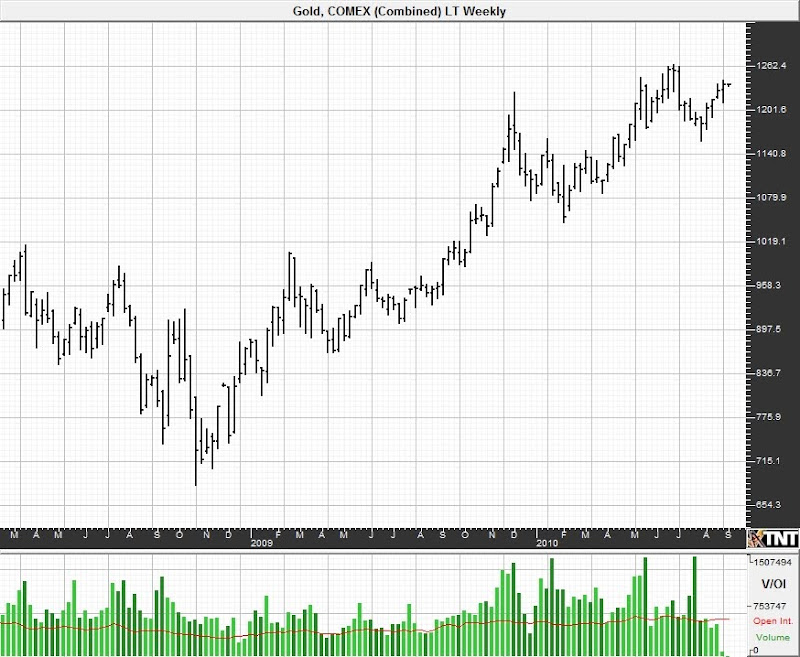
Past performance is not indicative of future results.
***chart courtesy Gecko Software’s Track n’ Trade Pro
The Supply Situation
According to the USGS, “nearly 100 countries” have reported some production of gold, but the majority of the world production has come from South Africa, Russia and the former member states of the USSR, the United States, Australia, and Canada. Gold can occur in many places in Earth’s crust and oceans, but to be a source of production, it must be concentrated enough to be recoverable. Mining of rich deposits, usually with six or more tons of gold, have been the primary source of gold production. Mining the precious metal isn’t cheap, and some mining companies in areas like South Africa can face increasing costs for fuel which could put a damper on any attempts to discover and mine additional gold resources. The high costs also make arguments for extraction from miniscule deposits like the oceans a moot point.
Recent estimates from the USGS suggest that there are nearly 100,000 tons of identified gold resources in the ground with nearly half in South Africa and roughly 12 percent in the United States.
From the latest USGS estimates, reserves are as illustrated in the following chart:
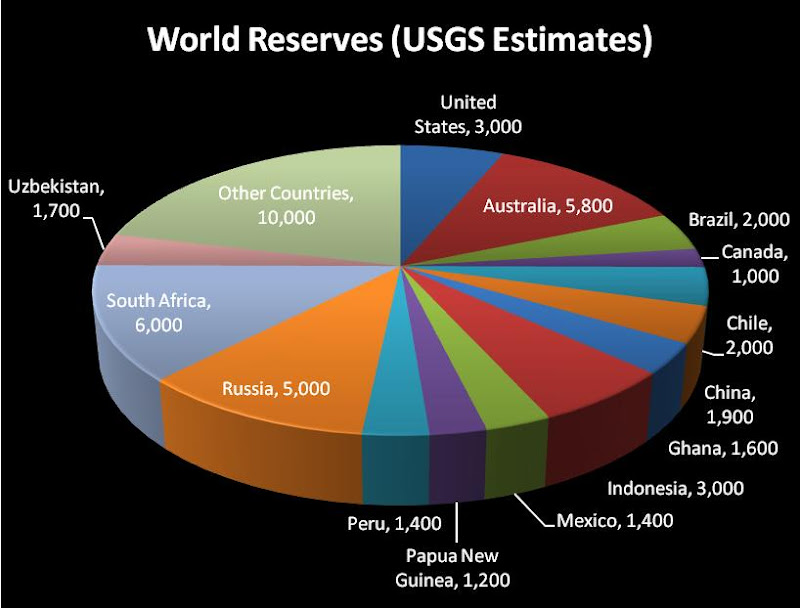
Data courtesy of the USGS
According to their report, reserves “tend to be replaced as they are mined” so it is unlikely that “complete exhaustion” would occur any time soon. Of course this primary sourcing of gold is not the only supply that needs to be considered. The secondary gold source, that which has already been mined and fabricated, is a huge part of the overall picture.
Estimates of the cumulative amount of gold mined put the above ground supply at over 140,000 metric tons. Of this amount, the World Gold Council suggests that the distribution is primarily divided between jewelry, industrial, investment, and official sectors (central banks, government bodies, etc.).
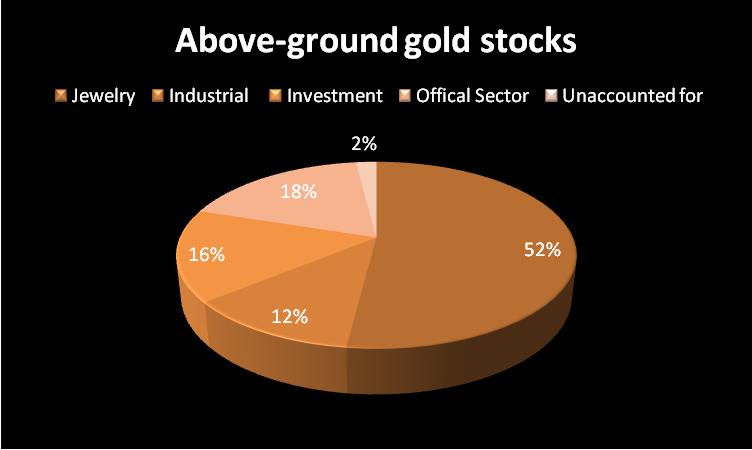
*Data courtesy of GFMS Ltd.
Central bank holdings within the Official Sector in the above figure are those held as reserve assets, and exclude the stocks which are owned and out on loan.
How much gold can actually be recovered from scrap? Higher grade gold like that from jewelry is easier to recover. Gold applied to base metals or alloyed can be accumulated and then refined. The following table illustrates just how much in the supply and demand picture is culled from recycled gold.
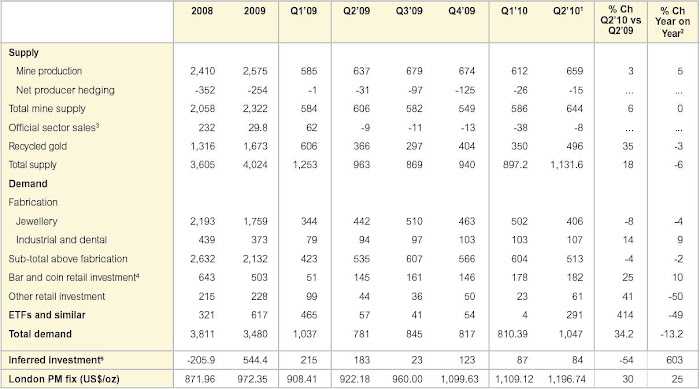
*Data courtesy of the GFMS
Summary – A Unique Picture
Peak gold has concerned itself with the idea that there will be a peak in production and then an eventual decline. Are gold resources in the ground finite? Theoretically, yes. Is there an immediate threat of production decline? Probably not. What this means for the average investor is that production numbers should be taken with a grain of salt and considered in light of the reality that unlike petroleum products, gold in above ground stocks can be used, refined, and used again. Obviously there has to be some consideration for gold which was mined and may not be usable any longer. Some estimates put the figure for such gold at roughly 7,000 tons. This would include gold which has been put into the ground again either via landfills or graves. Gold that is in use in such a way that renders it more difficult to obtain in the event of a shortage would include non-jewelry items like electronics. This may account for another 11,000 tons.
The large picture isn’t necessarily the potential for gold mines to be tapped out but rather the consequence of increasing interest and demand. Not all the gold currently above ground is available for sale or distribution. A large portion of the above ground gold is held for investment, monetary, or jewelry concerns. This means that although there is no immediate threat of shortage, there is a potentially higher demand amid fewer willing sellers. Gold demand on the world scene has been increasing and fabrication in both developing nations and industrial nations has gained ground.
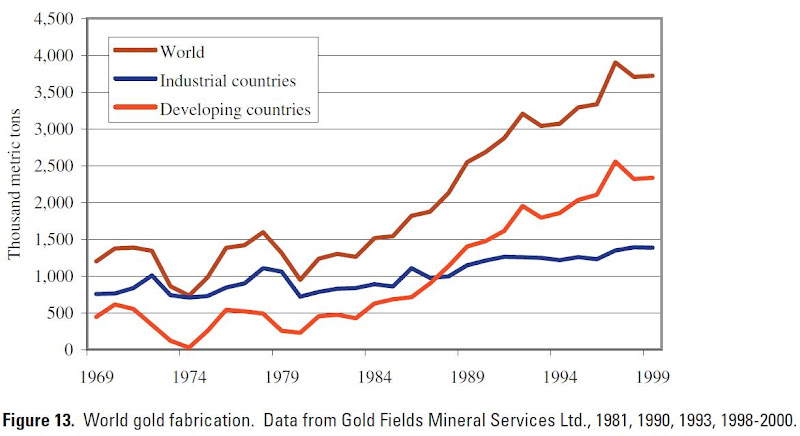
Central bank sales are limited by the Central Bank Gold Agreement and private investors and holdings of gold may not always be available for sale. Higher gold prices may spark an initial sale among the haves but they can also inspire the have-nots to seek gold out as a potential store of wealth as prices gain ground. Some outlets may be quick to point out production peaks, but finding the top in demand or prices may not be as easy.
One of the first fundamentals a trader learns is the importance of the supply and demand for a commodity or resource. Gold and other precious metals markets are no exception. Analyzing grains and other consumables requires all the details on consumption, production, and storage. For metals, the attention falls on investment demand and mining production. Unlike corn or wheat, new production or mining is limited to what is in the earth, an idea not overlooked by peak gold theorists.
Peak gold arguments, similar to those that drive peak oil theories, suggest that there is a pinnacle of production which can be reached and that following that peak, the mining or production levels will end up in terminal decline. More than one industry name has suggested that this peak was already reached at the beginning of the new millennium. Other publications, like those from the US Geological Survey (USGS), suggest that gold resources still exist to be discovered. Scrap and alloy uses may deflect some of the impact, but first it is important to evaluate where gold is and where it is coming from.

Past performance is not indicative of future results.
***chart courtesy Gecko Software’s Track n’ Trade Pro
The Supply Situation
According to the USGS, “nearly 100 countries” have reported some production of gold, but the majority of the world production has come from South Africa, Russia and the former member states of the USSR, the United States, Australia, and Canada. Gold can occur in many places in Earth’s crust and oceans, but to be a source of production, it must be concentrated enough to be recoverable. Mining of rich deposits, usually with six or more tons of gold, have been the primary source of gold production. Mining the precious metal isn’t cheap, and some mining companies in areas like South Africa can face increasing costs for fuel which could put a damper on any attempts to discover and mine additional gold resources. The high costs also make arguments for extraction from miniscule deposits like the oceans a moot point.
Recent estimates from the USGS suggest that there are nearly 100,000 tons of identified gold resources in the ground with nearly half in South Africa and roughly 12 percent in the United States.
From the latest USGS estimates, reserves are as illustrated in the following chart:

Data courtesy of the USGS
According to their report, reserves “tend to be replaced as they are mined” so it is unlikely that “complete exhaustion” would occur any time soon. Of course this primary sourcing of gold is not the only supply that needs to be considered. The secondary gold source, that which has already been mined and fabricated, is a huge part of the overall picture.
Estimates of the cumulative amount of gold mined put the above ground supply at over 140,000 metric tons. Of this amount, the World Gold Council suggests that the distribution is primarily divided between jewelry, industrial, investment, and official sectors (central banks, government bodies, etc.).

*Data courtesy of GFMS Ltd.
Central bank holdings within the Official Sector in the above figure are those held as reserve assets, and exclude the stocks which are owned and out on loan.
How much gold can actually be recovered from scrap? Higher grade gold like that from jewelry is easier to recover. Gold applied to base metals or alloyed can be accumulated and then refined. The following table illustrates just how much in the supply and demand picture is culled from recycled gold.

*Data courtesy of the GFMS
Summary – A Unique Picture
Peak gold has concerned itself with the idea that there will be a peak in production and then an eventual decline. Are gold resources in the ground finite? Theoretically, yes. Is there an immediate threat of production decline? Probably not. What this means for the average investor is that production numbers should be taken with a grain of salt and considered in light of the reality that unlike petroleum products, gold in above ground stocks can be used, refined, and used again. Obviously there has to be some consideration for gold which was mined and may not be usable any longer. Some estimates put the figure for such gold at roughly 7,000 tons. This would include gold which has been put into the ground again either via landfills or graves. Gold that is in use in such a way that renders it more difficult to obtain in the event of a shortage would include non-jewelry items like electronics. This may account for another 11,000 tons.
The large picture isn’t necessarily the potential for gold mines to be tapped out but rather the consequence of increasing interest and demand. Not all the gold currently above ground is available for sale or distribution. A large portion of the above ground gold is held for investment, monetary, or jewelry concerns. This means that although there is no immediate threat of shortage, there is a potentially higher demand amid fewer willing sellers. Gold demand on the world scene has been increasing and fabrication in both developing nations and industrial nations has gained ground.

Central bank sales are limited by the Central Bank Gold Agreement and private investors and holdings of gold may not always be available for sale. Higher gold prices may spark an initial sale among the haves but they can also inspire the have-nots to seek gold out as a potential store of wealth as prices gain ground. Some outlets may be quick to point out production peaks, but finding the top in demand or prices may not be as easy.
____________________________________________________________________
Disclaimer: The prices of precious metals and physical commodities are unpredictable and volatile. There is a substantial degree of a risk of loss in all trading. Past performance is not indicative of future results.
Last edited:
